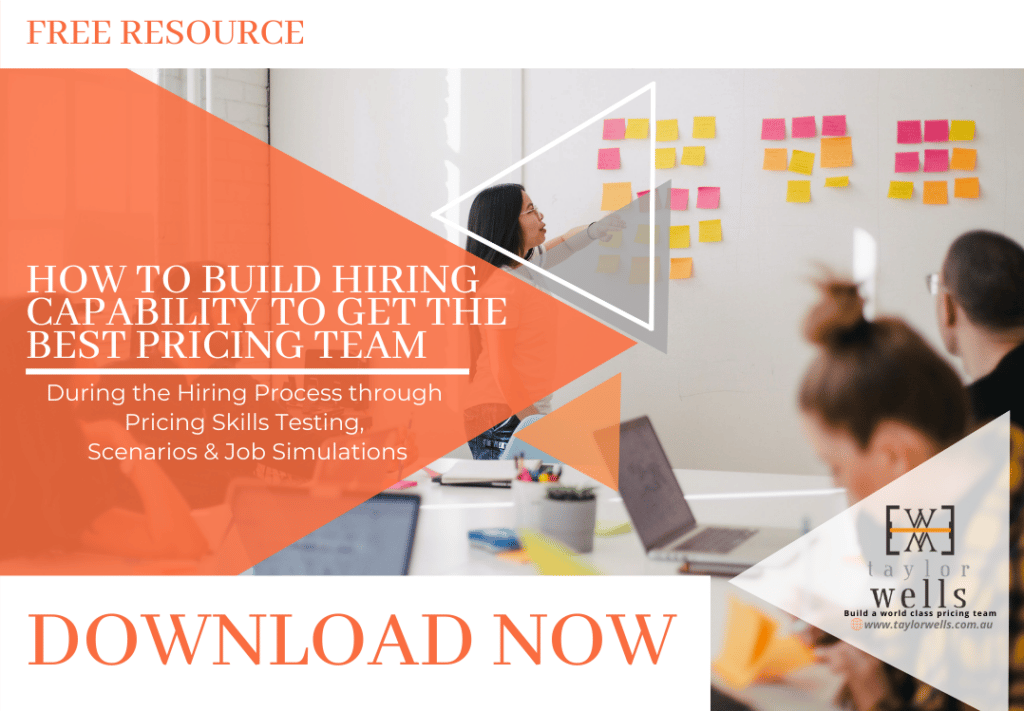
Job Hunting Guides: Top 5 Tips To Get Call Backs For Great Jobs 🐆
People often wonder why they never hear back from companies after they hit ‘send’ on the email with a CV attached or on the online job application. Have you ever had this familiar job hunting experience? Let’s have a look at some great job hunting guides that will transform your success rate!
>Download Now: Free PDF How To Build Hiring Capability To Get The Best Pricing Team
Recent developments have made job postings more accessible, but also introduced new hurdles for job hunters. Some people are unable to obtain suitable employment prospects as a result of poor job adverts. Others are not getting interviews because they do not meet specific qualifications. While others get interviews but no job offers! What’s the meaning of all this?
You’ve heard it time and again, whether you’re a newbie at job hunting or have had years of experience sorting out your applications. When it comes to job hunting, first impressions are critical! That applies to both online and personal job hunting.
If you are curious and want to learn what really happens behind the scenes in large corporations when you apply to their jobs, then read this blog on job hunting tips and guides for pricing management roles: A blue-chip company launches a search for an open pricing manager position.
In this article, we will give you the job hunting guides that you need. Instead of telling you what exactly to do, we give you a glimpse of what happens in the recruitment process. We show you case samples and how recruiters choose the best CVs. Then we explain why you might be having a hard time getting callbacks. This way, you will realise what you need to change or improve on.
At Taylor Wells, we believe that with the proper approach and commitment to your dream career, you can surpass job hunting obstacles and lack of confidence. By the end, you will discover the top job hunting guides that will assist you in eventually landing the employment that is perfect for you.
The Greatest Job Hunting Guides to Help You Navigate Your Career This Year
Employers and recruiters must be active in channels where job seekers are hunting. And guess what? Over half of all job searchers in Australia look for work online. Let’s look at some actual online job hunting stories.
Online Job Hunting Experiences and Guides
Sadly, technological innovation has brought different concerns, such as defending your privacy and maintaining your digital image. Fraud job postings, fake job websites, and employer impersonation are examples of threats that are continuously evolving into new forms. How can you combat these dangers?
1. Protect your privacy.
Some would tell you that privacy is gone in this day and age. This is completely false! Thinking that you don’t need to safeguard your privacy endangers not only you and your career but also the people close to you.
2. Steer clear from job scams.
Do not engage in the job advertisement or message until you have checked that the employer and opportunity are authentic! Never give any personal information, upload a CV or create an account unless you are 100% sure the offer is trustworthy.
After exploring online job hunting guides, let us investigate what actually occurs throughout a recruitment procedure. We are referring to case studies derived from real-life situations we witnessed during the last few years.
Job Hunting Guides: Case Examples
An internal recruiter, we’ll call John (aka a corporate recruiter that works inside the employer’s organisation and who usually gets paid a salary from an employer for filling open jobs in the company) has been notified that this is a key role enhancing the current pricing function.
This is 1 of 25 jobs John is managing this month, and pricing and revenue management is not a functional area he is familiar with.
After reading the job description from the line manager, John’s assumption about pricing is that it is like accountancy or management reporting. He starts the screening process with that view in mind.
He posts the job description on the company website and job boards. LinkedIn, and maybe SEEK, as it is the typical process.
It was very long and had a fair bit of business jargon in it. So before he posted the job, he edited the job description, cut it down and tried to make it sound more human and welcoming.
After a couple of weeks, the applications start rolling in and he has 100 people apply for the role.
John then does a quick database search using the company’s applicant tracking system to bring up some past applications.
Job Hunting Guides: Choosing the Best CVs
He’s pretty chuffed since he’s got 150 profiles to choose from; ‘There must be someone good on this list, right?’
Now, comes the more difficult part: choosing the best CVs to send on to the hiring managers.
John can’t send across 150 profiles to the hiring managers. Most hiring managers only really want to see 4 or 5 good CVs.
And, he’s also got a reputation to think about – he doesn’t want to be known as the recruiter who sends the business bad CVs.
So, he begins his own screening and filtering process. First, he ranks the CVs using the internal recruitment software. Out of the 150 CVs identified in the search so far, the applicant tracking system identifies and ranks the top 50 candidates based on a basic keyword search.
The system has eliminated 100 candidates straight off his list – 66% of the total applications and CVs. John hopes the system is right.
Now, he’s down to 50 CV profiles. 50% of these are older applications, and 50% are from online job ads.
At this point, he thinks he should call and pitch the role to all 25 past applicants.
However, he doesn’t really want to…
John remembers from experience that past applicants are not as keen as active job seekers. They take much more persuading (i.e. their job hunting is not so active) and like the detail on the role, team, company and culture, let alone the salary and perks.
John is also a bit nervous about the prospect of calling people. Why? He is unfamiliar with the role, mission and detail.
Out of the 25 candidates on his list to call, John knows only 2 people will show any interest in the role he’s describing – he typically converts 10% (a rough industry benchmark) but thinks it might be less for this role.
If we assume John has called and properly screened all ‘passive’ candidates (someone who is being considered for a position but is not actively searching for a job), he has another 25 ‘active’ applications to call and qualify (someone who is actively looking for a role and who submits an application to human resources departments).
He hasn’t got time to do this, so he asks some experienced colleagues what they think. They skim over the CVs quickly and pick out their top candidates.
He may call a few more applicants on the list and removes some more people – generally people with poor communication skills.
At the end of the screening process, he’ll look through his shortlist of CVs one last time and compare it to the job description.
He’ll keep CVs that he thinks are the best fit for the role and remove the rest and think he’s done a pretty good job considering…
His list of 150 is now down to 8 CVs. Then he’ll send across his list to the hiring manager and turn his attention to the other 24 jobs he’s got to fill this month.
We are done discussing the internal process of recruitment. Next, let’s address the main problem. Why are you not getting callbacks? What can you do about it?
Job Hunting Guides: Why are you not getting callbacks from companies?
In short, because many businesses use:
- A passive recruitment system built on the false belief that talented people will do anything to work for them when in reality they are not that fussed
- Admin intensive, red-tapped recruitment that essentially automates broken recruitment processes
- Stringent job ads that drive talent away
- Ad hoc and subjective screening and vetting protocols susceptible to human error and bias
- Recruiters with limited functional expertise or insight into business culture or strategy
Why is this happening?
After working in large corporations for over 13 years, I see most CEOS and executives don’t see it as their role to fix what only can be described as a dysfunctional-recruitment soap opera.
Recruitment is broken and keeps the smartest and most capable people away. Recruitment is soulless and dehumanising. It makes recruiters into robots, candidates into cattle, and shuts down the opportunity to understand high performance.
Regardless of investment in technology, recruitment is still a transactional meat market; trading CVs, LinkedIn profiles and references for people and cash. Job hunting guides need to be tweaked into a platform that allows recruitment and talent to know each other and fit.
Neither the business nor candidates have many opportunities to get to know each other properly – and the few interactions they do have lack significance.
Candidates go through the process without any real explanation of the role and business. Businesses go through the process without really getting to know the candidates.
Then, of course, there are the people who occupy this space: Recruitment is still an industry largely defined by spiv recruiters and unskilled workers.
Many agency staff have no background in HR, psychology, or business. Very few recruiters are domain and industry specialists.

Agency recruiters focus on their monthly commission and not on finding the right person for the role. On the other hand, internal recruiters are incentivised on completing the paperwork required to fill roles. We need to change all of this.
What is the problem with standard recruitment?
We delude ourselves for so long to the point that some applicants may even feel a loss of confidence in job hunting. Conventional recruitment is broken and flawed. No amount of creative job hunting and no matter how good will fix it.
Recruitment is exacerbating skills shortages and widespread disengagement, which is costing the Australian taxpayer $54 billion in lost productivity.
Bad hires destroy team morale and create dysfunctional teams. The number 1 reason people leave businesses is because of their line manager.
No one wants to work for a boss they dislike or even hate. Incompetent managers make bad mistakes, which impact the team and lead to revenue loss, angry customers and ongoing performance issues.
Hiring a distinct type often leads to a culture of drones and a tendency toward nonconformity. Hiring without clear criteria essentially means you are going through the process vaguely and do not know what you are looking for.
Using LinkedIn in Job Hunting Guides
Posting a job on LinkedIn to attract great pricing people through talent recruitment is a smoke and mirrors game for amateur recruiters and hiring managers.
LinkedIn promises to attract good candidates for your roles, but really it signals to your prospective applicants you are spending very little time, effort, thought and money on talent recruitment and finding the right person for the job.
LinkedIn job ads suggest you’re a conventional outfit with limited talent recruitment networks and pipelines. It suggests you treat people as a commodity.
Whacking up a job ad on LinkedIn looks cheap. It broadcasts desperation. Suggests time to hire is more important than the quality of hire. It indicates a lack of thought and cares in talent recruitment.
How you can use LinkedIn for talent recruitment!
If people are reading a job ad for a Head of Pricing or Director of Planning & Revenue Management role on LinkedIn they are likely to assume that the rest of your recruitment process is equally as predictable and transactional. Would they be wrong?
Our research on the Australian jobs market shows that Australian based businesses are becoming much more passive in their pursuit of talent recruitment – despite the diatribe of fighting the war on talent. See our blog on executive recruitment.
Only low-level unskilled work advertised on LinkedIn is prominent then. Now it’s everything. Even CEO roles are posted on LinkedIn.
Gone are the days of headhunting or building talent networks. Everyone is cutting costs and slapping job hunting in Australia up on LinkedIn. They are even congratulating themselves for searching hard for the best talent.
Our research shows that despite all of LinkedIn’s promises to deliver you the best candidates, it actually delivers very little:
- LinkedIn application only gives you visibility of active candidates and then a list of passive candidates that rarely fit the description.
- When you advertise on LinkedIn, you are essentially missing a large proportion of the market that is not looking for a job and a better fit for the role.
- Approaching people via a LinkedIn network still requires someone to filter, screen and sell the role to potential candidates.
- An algorithm and/or a recruiter with little insight into the discipline, role, company strategic objectives, transformation program, and strategy is hardly going to do a good job selling the role to prospective candidates.
- Experts in their field want answers to difficult questions before they even consider meeting you for an interview.
- Applicants applying directly to LinkedIn may have ulterior motives for applying for the job which may not sit well with you.
- Active job seekers may be desperate to leave their job or line manager. They may just want to live in Australia and tolerate anything to do so. They may job hop and want a change. Maybe incompetent and have been found out by their team. They may be fishing for salary advice or testing out their interview skills and not interested in the job at all.
- LinkedIn does not woo, qualify or vet applicants’ drives, motivations and values.
- Endorsements and testimonials do not definitive assessments of capability.
- People often give endorsements to receive them in return.
Of course, you can get good candidates applying to LinkedIn ads. However, initial screening is based on CVs and keyword searches. Good candidates still not getting an offer is a strong possibility.
〉〉〉 Get Your FREE Pricing Audit 〉〉〉
Bottomline: Job Hunting Guides
If you are a CEO, leader or innovator concerned about talent shortages and hiring yes men and women, then you should be very concerned about recruitment and how to do a job hunt online.
Not understanding your culture and why certain people thrive in the business before you recruit, will stop you from hiring the people that can help you transform and grow the business.
The talent that you want is out there. It’s just your standard recruitment regime is driving talent away and maintaining old habits you want to change. This is leading people to job hunt now.
Now’s the time to re-think recruitment strategy and implementation. And, let’s not leap into investing in AI to manage talent either.
There’s no point automating bad recruitment processes and practice just as much as there’s no point getting AI to replicate a bad recruitment model.
Businesses, like yours, are at high risk of losing talent to competitors through slow and ineffective recruitment processes. But worse of all, executives are still blaming recruiters and their tools rather than themselves.
Now’s the time to position recruitment as a catalyst for the change you want to see; and ensure great candidates are not seeking job hunting tips when they didn’t get a position. That is if your organisation is up to it!
For a comprehensive guide to creating the best pricing team for your company,
Download a complimentary whitepaper on How to Build Capability During a Hiring Process.
Are you a business in need of help to align your pricing strategy, people and operations to deliver an immediate impact on profit?
If so, please call (+61) 2 9000 1115.
You can also email us at team@taylorwells.com.au if you have any further questions.
Make your pricing world-class!
Related Posts
1 Comment
Leave a Reply Cancel reply
Categories
- marketing strategy (20)
- Organisational Design (14)
- Podcast (114)
- Pricing Capability (68)
- Pricing Career Advice (10)
- Pricing Recruitment (15)
- Pricing Strategy (199)
- Pricing Team Skills (10)
- Pricing Teams & Culture (15)
- Pricing Transformation (25)
- Revenue Model (10)
- Sales Effectiveness (15)
- Talent Management (5)
- Technical Pricing Skills (29)







Monster has been an active job web-site for 25 years and has evolved to remain competitive.